Drift Algal Accumulation in Ice Scour Pits Provides an Underestimated Ecological Subsidy in a Novel Antarctic Soft-Sediment Habitat
Abstract
Simple Summary
Abstract
1. Introduction
2. Materials and Methods
2.1. Study Site
2.2. Distribution and Characterization of Ice Pits
2.3. Drift Algae Composition among Ice Pits
2.4. Drift Algae Temporal Dynamics
2.5. Statistical Analysis
3. Results
3.1. Distribution and Characterization of Ice Pits
3.2. Drift Algal Biomass and Composition with Respect to Ice Pit Shape
3.3. Drift Algae Temporal Dynamics
4. Discussion
5. Conclusions
Supplementary Materials
Author Contributions
Funding
Institutional Review Board Statement
Informed Consent Statement
Data Availability Statement
Acknowledgments
Conflicts of Interest
References
- Sousa, W.P. The role of disturbance in natural communities. Annu. Rev. Ecol. Syst. 1984, 15, 353–391. [Google Scholar] [CrossRef]
- Zajac, R.N.; Whitlatch, R.B.; Thrush, S.F. Recolonization and succession in soft-sediment infaunal communities: The spatial scale of controlling factors. Hydrobiologia 1998, 375, 227. [Google Scholar] [CrossRef]
- Widdicombe, S.; Austen, M.C. The interaction between physical disturbance and organic enrichment: An important element in structuring benthic communities. Limnol. Oceanogr. 2001, 46, 1720–1733. [Google Scholar] [CrossRef]
- Dernie, K.M.; Kaiser, M.J.; Warwick, R.M. Recovery Rates of Benthic Communities Following Physical Disturbance. J. Anim. Ecol. 2003, 72, 1043–1056. [Google Scholar] [CrossRef]
- Herkül, K.; Kotta, J.; Rätsep, M. Effect of physical disturbance on the soft sediment benthic macrophyte and invertebrate community in the northern Baltic Sea. Boreal Environ. Res. 2011, 16, 209–219. [Google Scholar]
- Kim, J.H.; DeWreede, R.E. Effects of size and season of disturbance on algal patch recovery in a rocky intertidal community. Mar. Ecol. Prog. Ser. 1996, 133, 217–228. [Google Scholar] [CrossRef]
- Hall, S.J.; Harding, M.J.C. Physical disturbance and marine benthic communities: The effects of mechanical harvesting of cockles on non-target benthic infauna. J. Appl. Ecol. 1997, 34, 497–517. [Google Scholar] [CrossRef]
- Keough, M.J.; Quinn, G.P. Effects of periodic disturbances from trampling on rocky intertidal algal beds. Ecol. Appl. 1998, 8, 141–161. [Google Scholar] [CrossRef]
- Ramage, D.L.; Schiel, D.R. Patch dynamics and response to disturbance of the seagrass Zostera novazelandica on intertidal platforms in southern New Zealand. Mar. Ecol. Prog. Ser. 1999, 189, 275–288. [Google Scholar] [CrossRef]
- Boese, B.L. Effects of recreational clam harvesting on eelgrass (Zostera marina) and associated infaunal invertebrates: In situ manipulative experiments. Aquat. Bot. 2002, 73, 63–74. [Google Scholar] [CrossRef]
- Schiel, D.R.; Lilley, S.A. Gradients of disturbance to an algal canopy and the modification of an intertidal community. Mar. Ecol. Prog. Ser. 2007, 339, 1–11. [Google Scholar] [CrossRef]
- Wernberg, T.; Connell, S.D. Physical disturbance and subtidal habitat structure on open rocky coasts: Effects of wave exposure, extent and intensity. J. Sea Res. 2008, 59, 237–248. [Google Scholar] [CrossRef]
- Rumohr, H.; Bonsdorff, E.; Pearson, T.H. Zoobenthic succession in Baltic sedimentary habitats. Arch. Fish. Mar. Res. 1996, 44, 179–213. [Google Scholar]
- Powilleit, M.; Kleine, J.; Leuchs, H. Impacts of experimental dredged material disposal on a shallow, sublittoral macrofauna community in Mecklenburg Bay (western Baltic Sea). Mar. Pollut. Bull. 2006, 52, 386–396. [Google Scholar] [CrossRef] [PubMed]
- Smith, R.; Boyd, S.E.; Rees, H.L.; Dearnaley, M.P.; Stevenson, J.R. Effects of dredging activity on epifaunal communities—Surveys following cessation of dredging. Estuar. Coast. Shelf Sci. 2006, 70, 207–223. [Google Scholar] [CrossRef]
- Turner, J.; Chenoli, S.N.; Abu Samah, A.; Marshall, G.; Phillips, T.; Orr, A. Strong wind events in the Antarctic. J. Geophys. Res.-Atmos. 2009, 114, 25. [Google Scholar] [CrossRef]
- Barnes, D.K.A. The influence of ice on polar nearshore benthos. J. Mar. Biol. Assoc. UK 1999, 79, 401–407. [Google Scholar] [CrossRef]
- Clark, G.F.; Stark, J.S.; Palmer, A.S.; Riddle, M.J.; Johnston, E.L. The Roles of Sea-Ice, Light and Sedimentation in Structuring Shallow Antarctic Benthic Communities. PLoS ONE 2017, 12, e0168391. [Google Scholar] [CrossRef]
- Gutt, J.; Starmans, A. Quantification of iceberg impact and benthic recolonisation patterns in the Weddell Sea (Antarctica). Polar Biol. 2001, 24, 615–619. [Google Scholar] [CrossRef]
- Gutt, J. On the direct impact of ice on marine benthic communities, a review. Polar Biol. 2001, 24, 553–564. [Google Scholar] [CrossRef]
- Robinson, B.J.O.; Barnes, D.K.A.; Grange, L.J.; Morley, S.A. Intermediate ice scour disturbance is key to maintaining a peak in biodiversity within the shallows of the Western Antarctic Peninsula. Sci. Rep. 2021, 11, 8. [Google Scholar] [CrossRef] [PubMed]
- Fuentes, V.; Alurralde, G.; Meyer, B.; Aguirre, G.E.; Canepa, A.; Wolfl, A.C.; Hass, H.C.; Williams, G.N.; Schloss, I.R. Glacial melting: An overlooked threat to Antarctic krill. Sci. Rep. 2016, 6, 12. [Google Scholar] [CrossRef]
- Valdivia, N.; Garrido, I.; Bruning, P.; Pinones, A.; Miguel Pardo, L. Biodiversity of an Antarctic rocky subtidal community and its relationship with glacier meltdown processes. Mar. Environ. Res. 2020, 159, 104991. [Google Scholar] [CrossRef] [PubMed]
- Barnes, D.K.A.; Conlan, K.E. Disturbance, colonization and development of Antarctic benthic communities. Philos. Trans. R. Soc. B-Biol. Sci. 2007, 362, 11–38. [Google Scholar] [CrossRef]
- Deregibus, D.; Quartino, M.L.; Zacher, K.; Campana, G.L.; Barnes, D.K.A. Understanding the link between sea ice, ice scour and Antarctic benthic biodiversity-the need for cross-station and international collaboration. Polar Rec. 2017, 53, 143–152. [Google Scholar] [CrossRef]
- Barnes, P.W.; Rearic, D.M.; Reimnitz, E. Ice gouging characteristics and processes. In The Alaskan Beaufort Sea; Academic Press: Cambridge, MA, USA, 1984. [Google Scholar] [CrossRef]
- Lien, R.; Solheim, A.; Elverhøi, A.; Rokoengen, K. Iceberg scouring and sea bed morphology on the eastern Weddell Sea shelf, Antarctica. Polar Res. 1989, 7, 43–57. [Google Scholar] [CrossRef]
- Gutt, J.; Starmans, A.; Dieckmann, G. Impact of iceberg scouring on polar benthic habitats. Mar. Ecol. Prog. Ser. 1996, 137, 311–316. [Google Scholar] [CrossRef]
- Maznev, S.; Ogorodov, S.; Baranskaya, A.; Vergun, A.; Arkhipov, V.; Bukharitsin, P. Ice-Gouging Topography of the Exposed Aral Sea Bed. Remote Sens. 2019, 11, 113. [Google Scholar] [CrossRef]
- Josenhans, H.W.; Zevenhuizen, J.; Klassen, R.A. The quaternary geology of the labrador shelf. Can. J. Earth Sci. 1986, 23, 1190–1213. [Google Scholar] [CrossRef]
- Barnes, P.W.; Lien, R. Icebergs rework shelf sediments to 500 m off Antarctica. Geology 1988, 16, 1130. [Google Scholar] [CrossRef]
- Newton, A.M.W.; Huuse, M.; Brocklehurst, S.H. Buried iceberg scours reveal reduced North Atlantic Current during the stage 12 deglacial. Nat. Commun. 2016, 7, 7. [Google Scholar] [CrossRef] [PubMed]
- Goff, J.A.; Austin, J.A. Seismic and bathymetric evidence for four different episodes of iceberg scouring on the New Jersey outer shelf: Possible correlation to Heinrich events. Mar. Geol. 2009, 266, 244–254. [Google Scholar] [CrossRef]
- Carlson, P.R.; Hooge, P.N.; Cochrane, G.R. Discovery of 100–160-year-old iceberg gouges and their relation to halibut habitat in Glacier Bay, Alaska. In Benthic Habitats and the Effects of Fishing; Barnes, B.W., Thomas, J.P., Eds.; American Fisheries Society Symposium: Bethesda, MD, USA, 2005; Volume 41, pp. 235–243. [Google Scholar]
- Richardson, M.G. The distribution of Antarctic marine macroalgae related to depth and substrate. Antarct. Surv. Bull. 1979, 49, 1–13. [Google Scholar]
- Brouwer, P.E.M. Decomposition in situ of the sublittoral Antarctic macroalga Desmarestia anceps Montagne. Polar Biol. 1996, 16, 129–137. [Google Scholar] [CrossRef]
- Belderson, R.H.; Wilson, J.B. Iceberg plough marks in the vicinity of the Norwegian Trough. Norsk Geologisk Tidsskrift 1973, 53, 323–328. [Google Scholar]
- Pilkington, G.R.; Marcellus, R.W. Methods of Determining Pipeline Trench Depths in the Canadian Beaufort Sea. In Proceedings of the International Conference on Port and Ocean Engineering Under Arctic Conditions, POAC 81, Quebec City, QC, Canada, 27–31 July 1981; Volume 2, p. 684. [Google Scholar]
- Pelletier, B.R.; Shearer, J.M. Sea bottom scouring in the Beaufort Sea of the Arctic Ocean. In Proceedings 24th Internatioal Geological Congress; International Geological Congress: Montreal, QC, Canada, 1972; p. 251. [Google Scholar]
- Brooks, L.D. The Coast and Shelf of the Beaufort Sea; Reed, J.C., Sater, J.E., Eds.; Arctic Institute of North America: Arlington, VA, USA, 1974; p. 355. [Google Scholar]
- Wahlgren, R.J. Ice-Scour Tracks on the Beaufort Sea Continental Shelf; Their Form and an Interpretation of the Processes Creating Them. Master’s Thesis, Carleton University, Ottawa, ON, Canada, 1979. [Google Scholar]
- Reimnitz, E.; Barnes, P.W. The Coast and Shelf of the Beaufort Sea; Reed, J.C., Sater, J.E., Eds.; Arctic Institute of North America: Arlington, VA, USA, 1974; p. 301. [Google Scholar]
- Thor, D.R.; Nelson, C.H. The Eastern Bering Sea Shelf: Oceanography and Resources; Hood, D.W., Calder, J.A., Eds.; National Oceanic and Atmospheric Administration, University of Washington Press: Seattle, WA, USA, 1981; Volume 1, p. 279. [Google Scholar]
- Brown, C.S.; Newton, A.M.W.; Huuse, M.; Buckley, F. Iceberg scours, pits, and pockmarks in the North Falkland Basin. Mar. Geol. 2017, 386, 140–152. [Google Scholar] [CrossRef]
- Smale, D.A.; Barnes, D.K.A.; Fraser, K.P.P.; Peck, L.S. Benthic community response to iceberg scouring at an intensely disturbed shallow water site at Adelaide Island, Antarctica. Mar. Ecol. Prog. Ser. 2008, 355, 85–94. [Google Scholar] [CrossRef]
- Smale, D.A.; Barnes, D.K.A.; Fraser, K.P.P. The influence of ice scour on benthic communities at three contrasting sites at Adelaide Island, Antarctica. Austral. Ecol. 2007, 32, 878–888. [Google Scholar] [CrossRef]
- Peck, L.S.; Brockington, S.; Vanhove, S.; Beghyn, M. Community recovery following catastrophic iceberg impacts in a soft-sediment shallow-water site at Signy Island, Antarctica. Mar. Ecol. Prog. Ser. 1999, 186, 1–8. [Google Scholar] [CrossRef]
- Ebeling, A.W.; Laur, D.R.; Rowley, R.J. Severe storm disturbances and reversal of community structure in a southern California kelp forest. Mar. Biol. 1985, 84, 287–294. [Google Scholar] [CrossRef]
- Filbee-Dexter, K.; Scheibling, R.E. Hurricane-mediated defoliation of kelp beds and pulsed delivery of kelp detritus to offshore sedimentary habitats. Mar. Ecol. Prog. Ser. 2012, 455, 51–64. [Google Scholar] [CrossRef]
- Krumhansl, K.A.; Lee, J.M.; Scheibling, R.E. Grazing damage and encrustation by an invasive bryozoan reduce the ability of kelps to withstand breakage by waves. J. Exp. Mar. Biol. Ecol. 2011, 407, 12–18. [Google Scholar] [CrossRef]
- Krumhansl, K.A.; Scheibling, R.E. Production and fate of kelp detritus. Mar. Ecol. Prog. Ser. 2012, 467, 281–302. [Google Scholar] [CrossRef]
- Duggins, D.O.; Gomez-Buckley, M.C.; Buckley, R.M.; Lowe, A.T.; Galloway, A.W.E.; Dethier, M.N. Islands in the stream: Kelp detritus as faunal magnets. Mar. Biol. 2016, 163, 10. [Google Scholar] [CrossRef]
- Zobell, C.E. Drift seaweeds on San Diego County beaches. Nova Hedwig. 1971, 32, 269–314. [Google Scholar]
- Duggins, D.; Eckman, J.E.; Siddon, C.E.; Klinger, T. Interactive roles of mesograzers and current flow in survival of kelps. Mar. Ecol. Prog. Ser. 2001, 223, 143–155. [Google Scholar] [CrossRef]
- Wilce, R.T. The “Arctic Stamp”, its imprint on an endangered marine flora—The Arctic benthic algal flora and its environment seen from 65 years of Arctic research. Perspect. Phycol. 2016, 3, 155–180. [Google Scholar] [CrossRef]
- Pedersen, M.F.; Filbee-Dexter, K.; Norderhaug, K.M.; Fredriksen, S.; Frisk, N.L.; Fagerli, C.W.; Wernberg, T. Detrital carbon production and export in high latitude kelp forests. Oecologia 2020, 192, 227–239. [Google Scholar] [CrossRef]
- Jaramillo, E.; De la Huz, R.; Duarte, C.; Contreras, H. Algal wrack deposits and macroinfaunal arthropods on sandy beaches of the Chilean coast. Rev. Chil. Hist. Nat. 2006, 79, 337–351. [Google Scholar] [CrossRef]
- Biber, P.D. Hydrodynamic transport of drifting macroalgae through a tidal cut. Estuar. Coast. Shelf Sci. 2007, 74, 565–569. [Google Scholar] [CrossRef]
- Hobday, A.J. Persistence and transport of fauna on drifting kelp (Macrocystis pyrifera (L.) C. Agardh) rafts in the Southern California Bight. J. Exp. Mar. Biol. Ecol. 2000, 253, 75–96. [Google Scholar] [CrossRef] [PubMed]
- Reise, K.; Lackschewitz, D.; Wegner, K.M. Marine turf of an invasive alga expels lugworms from the lower shore. Mar. Biol. 2021, 169, 16. [Google Scholar] [CrossRef]
- Macaya, E.C.; Boltana, S.; Hinojosa, I.A.; Macchiavello, J.E.; Valdivia, N.A.; Vasquez, N.R.; Buschmann, A.H.; Vasquez, J.A.; Vega, J.M.A.; Thiel, M. Presence of sporophylls in floating kelp rafts of Macrocystis spp. (Phaeophyceae) along the Chilean Pacific coast. J. Phycol. 2005, 41, 913–922. [Google Scholar] [CrossRef]
- Gerard, V.A. Some Aspects of Material Dynamics and Energy Flow in a Kelp Forest in Monterey Bay, California. Ph.D. Thesis, University of California, Santa Cruz, CA, USA, 1976. [Google Scholar]
- Norkko, A.; Bonsdorff, E. Altered benthic prey-availability due to episodic oxygen deficiency caused by drifting algal mats. Mar. Ecol.-Pubbl. Stn. Zool. Napoli 1996, 17, 355–372. [Google Scholar] [CrossRef]
- Sundback, K.; Jonsson, B.; Nilsson, P.; Lindstrom, I. Impact of accumulating drifting macroalgae on a shallow-water sediment system—An experimental-study. Mar. Ecol. Prog. Ser. 1990, 58, 261–274. [Google Scholar] [CrossRef]
- Krause-Jensen, D.; Duarte, C.M. Substantial role of macroalgae in marine carbon sequestration. Nat. Geosci. 2016, 9, 737–742. [Google Scholar] [CrossRef]
- Norkko, A.; Bonsdorff, E. Rapid zoobenthic community responses to accumulations of drifting algae. Mar. Ecol. Prog. Ser. 1996, 131, 143–157. [Google Scholar] [CrossRef]
- Norkko, J.; Bonsdorff, E.; Norkko, A. Drifting algal mats as an alternative habitat for benthic invertebrates: Species specific responses to a transient resource. J. Exp. Mar. Biol. Ecol. 2000, 248, 79–104. [Google Scholar] [CrossRef]
- Norkko, A.; Thrush, S.F.; Cummings, V.J.; Gibbs, M.M.; Andrew, N.L.; Norkko, J.; Schwarz, A.M. Trophic structure of coastal antarctic food webs associated with changes in sea ice and food supply. Ecology 2007, 88, 2810–2820. [Google Scholar] [CrossRef]
- Polis, G.A.; Strong, D.R. Food web complexity and community dynamics. Am. Nat. 1996, 147, 813–846. [Google Scholar] [CrossRef]
- Norkko, A.; Thrush, S.F.; Cummings, V.J.; Funnell, G.A.; Schwarz, A.M.; Andrew, N.L.; Hawes, I. Ecological role of Phyllophora antarctica drift accumulations in coastal soft sediment communities of McMurdo Sound, Antarctica. Polar Biol. 2004, 27, 482–494. [Google Scholar] [CrossRef]
- Valdivia, N.; Garcés-Vargas, J.; Garrido, I.; Gómez, I.; Huovinen, P.; Navarro, N.P.; Macaya, E.C.; Pardo, L.M. Beta Diversity of Antarctic and Sub-Antarctic Benthic Communities Reveals a Major Role of Stochastic Assembly Processes. Front. Mar. Sci. 2021, 8, 780268. [Google Scholar] [CrossRef]
- Griffiths, H.J. Antarctic Marine Biodiversity—What Do We Know About the Distribution of Life in the Southern Ocean? PLoS ONE 2010, 5, e0011683. [Google Scholar] [CrossRef] [PubMed]
- Pollock, N.W. Scientific diving in Antarctica: History and current practice. Diving Hyperb. Med. 2007, 37, 204–211. [Google Scholar]
- Convey, P.; Peck, L.S. Antarctic environmental change and biological responses. Sci. Adv. 2019, 5, 16. [Google Scholar] [CrossRef] [PubMed]
- Rogers, A.D.; Frinault, B.A.V.; Barnes, D.K.A.; Bindoff, N.L.; Downie, R.; Ducklow, H.W.; Friedlaender, A.S.; Hart, T.; Hill, S.L.; Hofmann, E.E.; et al. Antarctic Futures: An Assessment of Climate-Driven Changes in Ecosystem Structure, Function, and Service Provisioning in the Southern Ocean. In Annual Review of Marine Science; Carlson, C.A., Giovannoni, S.J., Eds.; Annual Review; Palo Alto: Santa Clara, CA, USA, 2020; Volume 12, pp. 87–120. [Google Scholar]
- Siegert, M.; Atkinson, A.; Banwell, A.; Brandon, M.; Convey, P.; Davies, B.; Downie, R.; Edwards, T.; Hubbard, B.; Marshall, G.; et al. The Antarctic Peninsula Under a 1.5 degrees C Global Warming Scenario. Front. Environ. Sci. 2019, 7, 7. [Google Scholar] [CrossRef]
- Wiencke, C.; Clayton, M.N. Antarctic Seaweeds; Wägele, J.-W., Ruggell, L., Eds.; Koeltz Botanical Books: Schmitten, Germany, 2002; Volume 9, p. 239. [Google Scholar]
- Gomez, I. Flora Marina Antártica: Patrimonio de Biodiversidad; Editorial Kuktrun: Valdivia, Chile, 2015. [Google Scholar]
- Perry, J.J.; Brodt, A.; Skonberg, D.I. Influence of dry salting on quality attributes of farmed kelp (Alaria esculenta) during long-term refrigerated storage. LWT-Food Sci. Technol. 2019, 114, 6. [Google Scholar] [CrossRef]
- Huovinen, P.; Gómez, I. Underwater Light Environment of Antarctic Seaweeds. In Antarctic Seaweeds: Diversity, Adaptation and Ecosystem Services; Gómez, I., Huovinen, P., Eds.; Springer International Publishing: Cham, Switzerland, 2020; pp. 131–153. [Google Scholar]
- Snelgrove, P.V.R. Getting to the bottom of marine biodiversity: Sedimentary habitats—Ocean bottoms are the most widespread habitat on Earth and support high biodiversity and key ecosystem services. Bioscience 1999, 49, 129–138. [Google Scholar] [CrossRef]
- Barnes, D.K.A.; Fleming, A.; Sands, C.J.; Quartino, M.L.; Dereqibus, D. Icebergs, Sea ice, blue carbon and Antarctic climate feedbacks. Philos. Trans. R. Soc. A-Math. Phys. Eng. Sci. 2018, 376, 15. [Google Scholar] [CrossRef]
- Ingels, J.; Aronson, R.B.; Smith, C.R.; Baco, A.; Bik, H.M.; Blake, J.A.; Brandt, A.; Cape, M.; Demaster, D.; Dolan, E.; et al. Antarctic ecosystem responses following ice-shelf collapse and iceberg calving: Science review and future research. Wiley Interdiscip. Rev.-Clim. Chang. 2021, 12, 28. [Google Scholar] [CrossRef]
- Dorschel, B.; Hehemann, L.; Viquerat, S.; Warnke, F.; Dreutter, S.; Tenberge, Y.S.; Accettella, D.; An, L.; Barrios, F.; Bazhenova, E.; et al. The International Bathymetric Chart of the Southern Ocean Version 2. Sci. Data 2022, 9, 13. [Google Scholar] [CrossRef] [PubMed]
- Barnes, D.K.A.; Souster, T. Reduced survival of Antarctic benthos linked to climate-induced iceberg scouring. Nat. Clim. Chang. 2011, 1, 365–368. [Google Scholar] [CrossRef]
- Rieperkirchner, M. Microbial-degradation of north-sea macroalgae-field and laboratory studies. Bot. Mar. 1989, 32, 241–252. [Google Scholar] [CrossRef]
- Macaya, E.C.; Rothausler, E.; Thiel, M.; Molis, M.; Wahl, M. Induction of defenses and within-alga variation of palatability in two brown algae from the northern-central coast of Chile: Effects of mesograzers and UV radiation. J. Exp. Mar. Biol. Ecol. 2005, 325, 214–227. [Google Scholar] [CrossRef]
- Zenteno, L.; Cardenas, L.; Valdivia, N.; Gomez, I.; Hofer, J.; Garrido, I.; Pardo, L.M. Unraveling the multiple bottom-up supplies of an Antarctic nearshore benthic community. Prog. Oceanogr. 2019, 174, 55–63. [Google Scholar] [CrossRef]
- Norkko, A.; Bonsdorff, E. Population responses of coastal zoobenthos to stress induced by drifting algal mats. Mar. Ecol. Prog. Ser. 1996, 140, 141–151. [Google Scholar] [CrossRef]
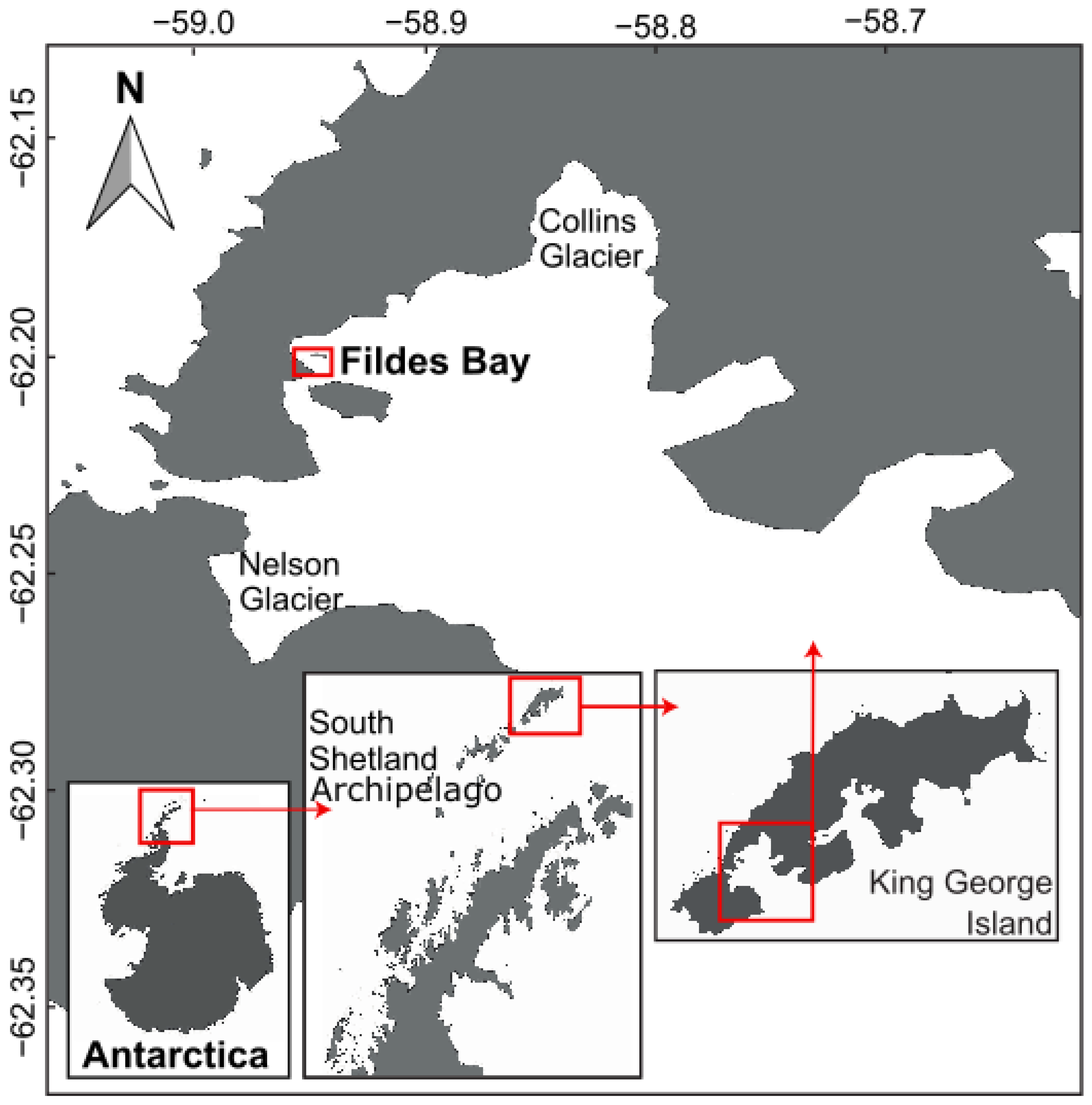

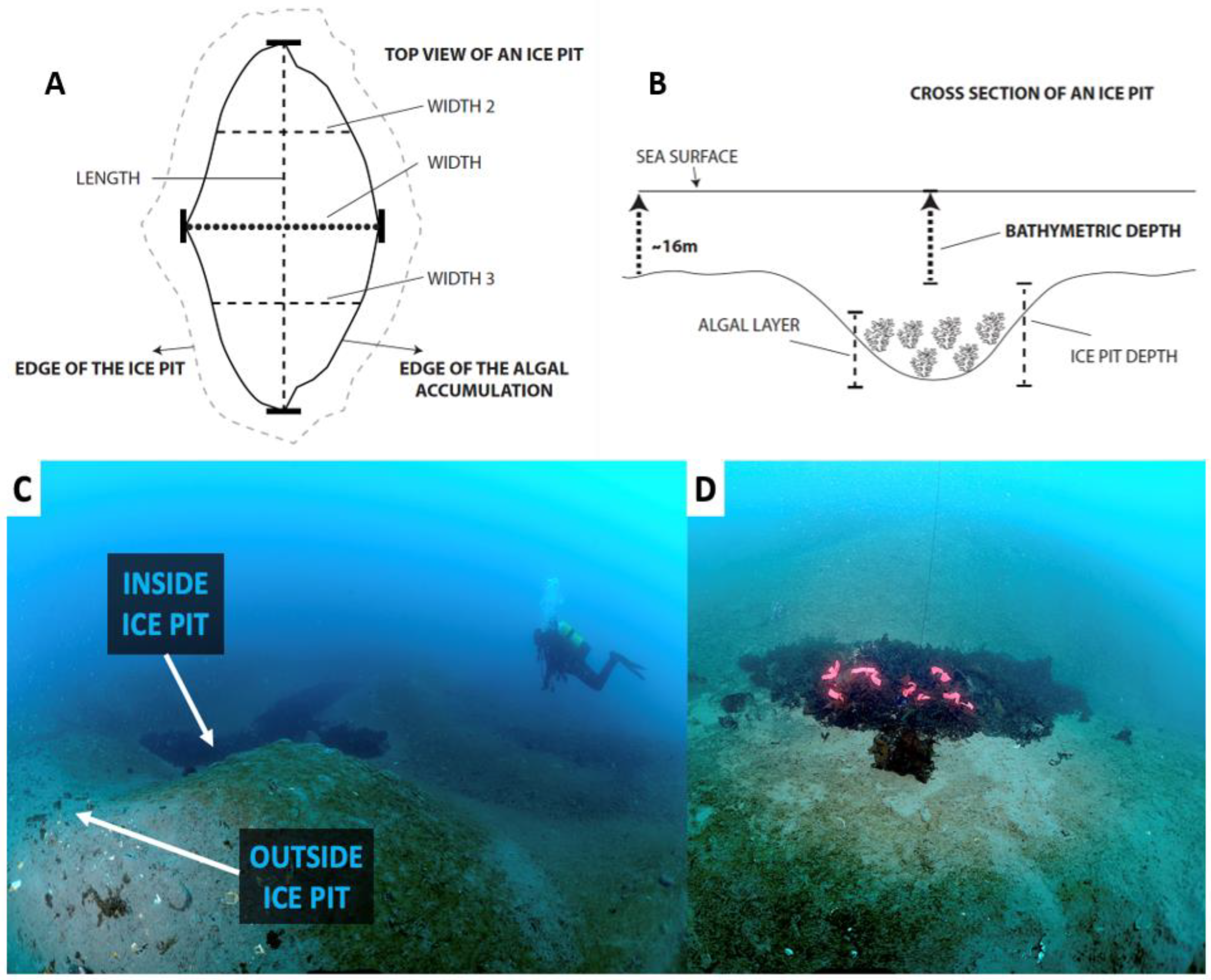
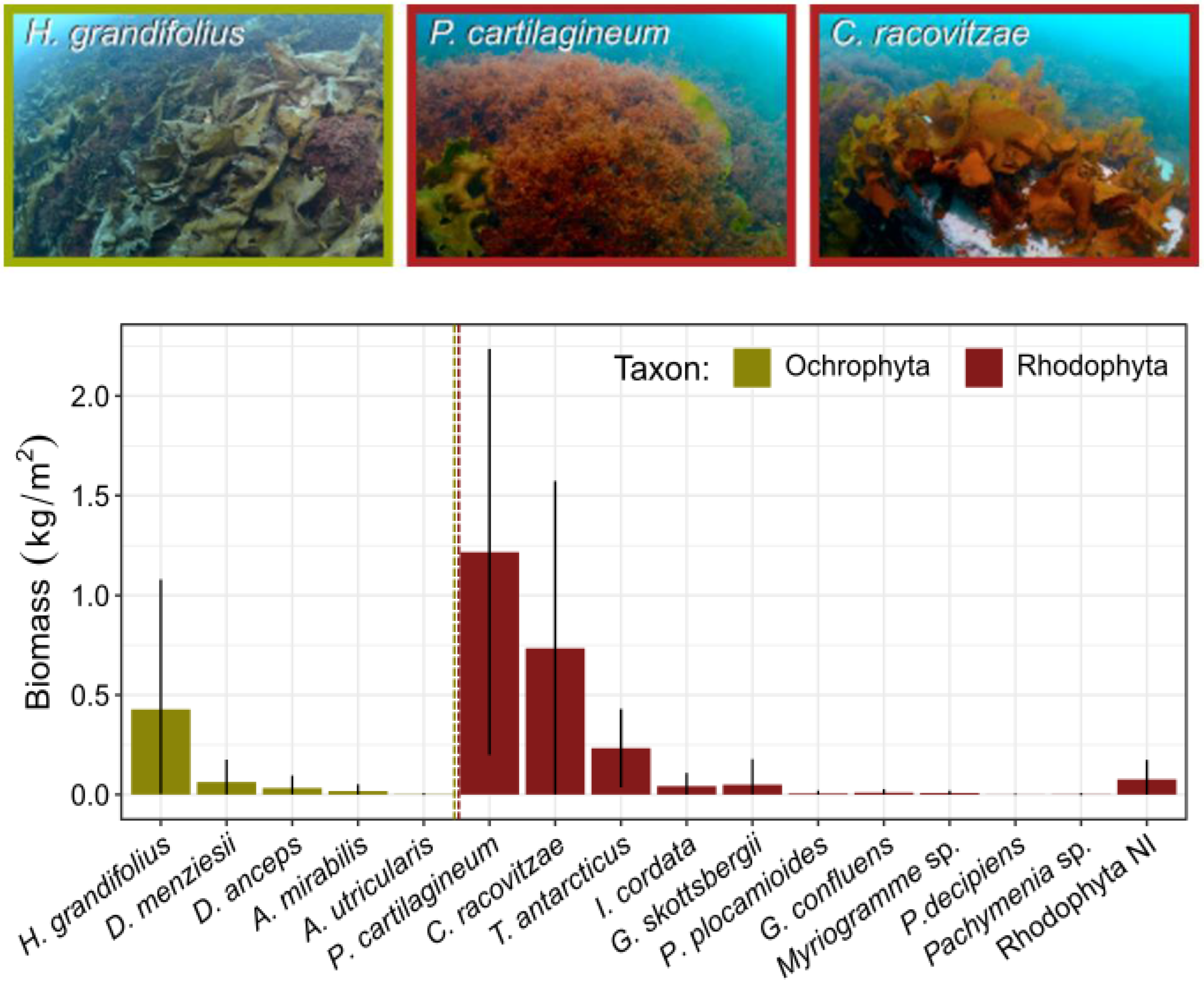
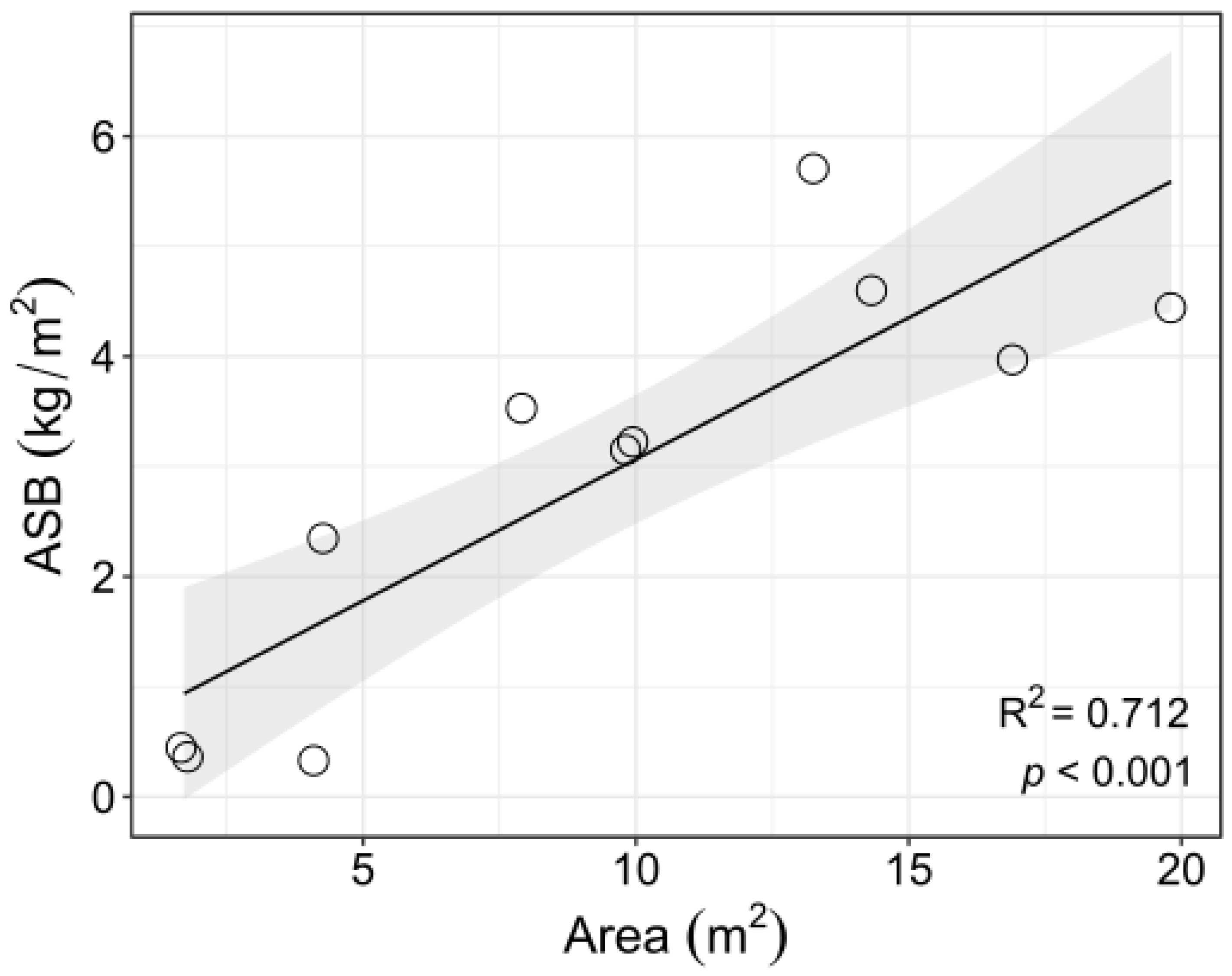

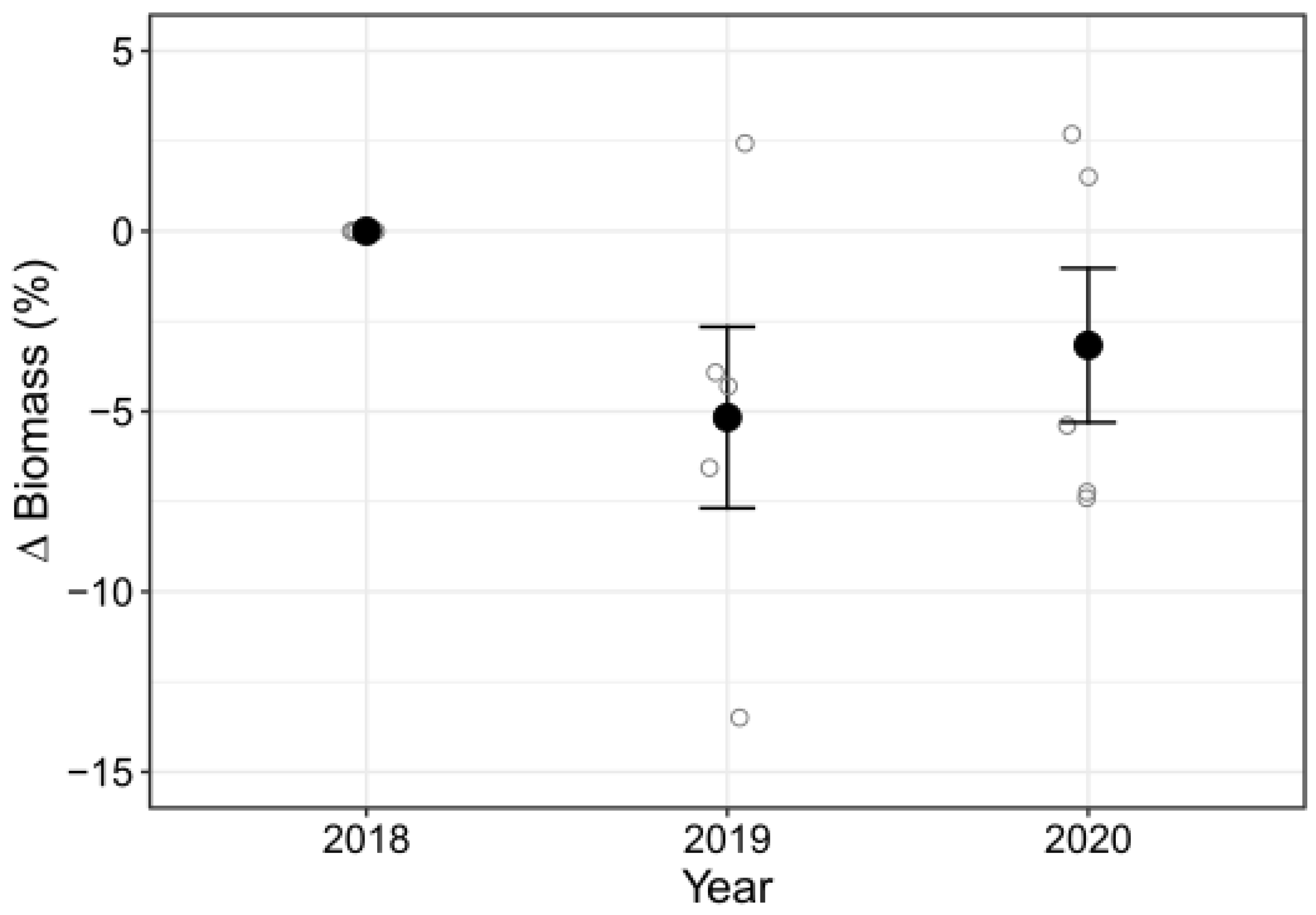
| Icepit | Length (m) | Width (m) | Algal Thickness (m) | Algal Pit Area (m2) | Algal Pit Volume (m3) | ASB (kg/m2) | Algal Density (kg/m3) | Estimated Total Biomass (kg) |
|---|---|---|---|---|---|---|---|---|
| A | 6.50 | 1.93 | 0.10 | 9.85 | 0.66 | 3.22 | 32.2 | 21.2 |
| B | 3.50 | 1.50 | 0.15 | 4.12 | 0.41 | 0.39 | 2.57 | 1.06 |
| C | 6.00 | 1.67 | 0.15 | 7.87 | 0.79 | 3.48 | 23.2 | 18.3 |
| D | 3.20 | 1.70 | 0.15 | 4.27 | 0.43 | 2.35 | 15.7 | 6.69 |
| E | 2.00 | 1.10 | 0.15 | 1.73 | 0.17 | 0.40 | 2.68 | 0.46 |
| F | 10.10 | 1.67 | 0.15 | 13.25 | 1.32 | 5.65 | 37.6 | 49.9 |
| G | 6.90 | 1.83 | 0.15 | 9.92 | 0.99 | 3.19 | 21.3 | 21.1 |
| I | 2.30 | 0.95 | 0.15 | 1.72 | 0.17 | 0.39 | 2.60 | 0.45 |
| L | 7.60 | 2.40 | 0.20 | 14.33 | 1.91 | 4.62 | 23.1 | 44.2 |
| Q | 8.70 | 2.90 | 0.15 | 19.82 | 1.98 | 4.44 | 29.6 | 58.7 |
| S | 6.80 | 3.17 | 0.15 | 16.93 | 1.69 | 4.01 | 26.7 | 45.2 |
| H | 6.50 | 4.27 | 0.20 | 21.80 | 2.91 | - | - | - |
| J | 2.70 | 1.50 | 0.15 | 3.18 | 0.32 | - | - | - |
| M | 3.60 | 2.80 | 0.15 | 7.92 | 0.79 | - | - | - |
| O | 1.00 | 1.00 | 0.15 | 0.79 | 0.08 | - | - | - |
| P | 1.30 | 0.80 | 0.15 | 0.82 | 0.08 | - | - | - |
| R | 7.20 | 3.40 | 0.20 | 19.23 | 2.56 | - | - | - |
| Eucl. Dist. X | Units | Eucl. Dist. Y | Units | Mantel r | p (perm) |
|---|---|---|---|---|---|
| Ice pit shape | m | Ice pit location | m | 0.072 | 0.177 |
| pit length | N coordinate | ||||
| pit width | E coordinate | ||||
| pit depth | bathymetric depth | ||||
| Ice pit shape | m | Algal composition | g/m2 | 0.571 | * 0.001 |
| pit length | biomass sp. 1 | ||||
| pit width | biomass sp. 2 | ||||
| pit depth | … | ||||
| biomass sp. 16 |
| Phylum, Species | ASB (kg/m2) | St. Dev (kg/m2) |
|---|---|---|
| Ochrophyta | ||
| Himantothallus grandifolius | 0.43 | 0.65 |
| Desmarestia anceps | 0.03 | 0.06 |
| Desmarestia menziesii | 0.06 | 0.11 |
| Ascoseira mirabilis | 0.02 | 0.04 |
| Adenocystis utricularis | 0.01 | 0.01 |
| Rhodophyta | ||
| Plocamium cartilagineum | 1.22 | 1.02 |
| Trematocarpus antarcticus | 0.23 | 0.20 |
| Curdiea racovitzae | 0.74 | 0.84 |
| Iridaea cordata | 0.04 | 0.07 |
| Georgiella confluens | 0.01 | 0.02 |
| Gigartina skottsbergii | 0.05 | 0.13 |
| Pantoneura plocamioides | 0.01 | 0.02 |
| Palmaria decipiens | 0.01 | 0.01 |
| Pachymenia sp. | 0.01 | 0.02 |
| Myriogramme sp. | 0.01 | 0.02 |
| Chlorophyta * | ||
| Monostroma hariotii | <0.01 | 0.01 |
| Response | Predictor | Coefficient | St. Err | t | Pr (>|t|) | |
|---|---|---|---|---|---|---|
| Total Biomass (kg) | Coord. E (m) | −9.53 | 2.12 | −4.51 | 0.011 | * |
| Coord. N (m) | −0.53 | 0.12 | −4.28 | 0.013 | * | |
| Pit Depth (m) | 171.92 | 82.50 | 2.08 | 0.106 | ||
| Bathym. Depth (m) | 0.81 | 10.22 | 0.08 | 0.941 | ||
| Coord. E: Bathym. Depth | 0.59 | 0.13 | 4.54 | 0.011 | * | |
| Pit Depth: Bathym. Depth | −10.60 | 4.81 | −2.21 | 0.092 | ||
| ASB (kg/m2) | Coord. E (m) | 0.03 | 0.01 | 4.70 | 0.018 | * |
| Coord. N (m) | −0.01 | 0.01 | −2.27 | 0.108 | ||
| Bathym. Depth (m) | 0.77 | 0.44 | 1.74 | 0.181 | ||
| Pit Depth (m) | 7.08 | 2.94 | 2.41 | 0.095 | ||
| Length (m) | 0.48 | 0.06 | 7.99 | 0.004 | * | |
| Width (m) | 0.42 | 0.25 | 1.66 | 0.195 | ||
| Bathym. Depth: Pit Depth | −0.42 | 0.17 | −2.46 | 0.091 | ||
| Richness (S) | Coord. E (m) | 0.99 | 0.42 | 2.34 | 0.079 | |
| Coord. N (m) | 0.07 | 0.03 | 2.35 | 0.078 | ||
| Bathym. Depth (m) | 3.07 | 0.99 | 3.11 | 0.036 | * | |
| Pit Depth (m) | 2.03 | 0.99 | 2.05 | 0.110 | ||
| Length (m) | 1.12 | 0.34 | 3.34 | 0.029 | * | |
| Coord. E: Bathym. Depth | −0.06 | 0.03 | −2.34 | 0.080 |
Disclaimer/Publisher’s Note: The statements, opinions and data contained in all publications are solely those of the individual author(s) and contributor(s) and not of MDPI and/or the editor(s). MDPI and/or the editor(s) disclaim responsibility for any injury to people or property resulting from any ideas, methods, instructions or products referred to in the content. |
© 2023 by the authors. Licensee MDPI, Basel, Switzerland. This article is an open access article distributed under the terms and conditions of the Creative Commons Attribution (CC BY) license (https://creativecommons.org/licenses/by/4.0/).
Share and Cite
Garrido, I.; Hawk, H.L.; Bruning, P.; Pardo, L.M.; Johnson, L.E. Drift Algal Accumulation in Ice Scour Pits Provides an Underestimated Ecological Subsidy in a Novel Antarctic Soft-Sediment Habitat. Biology 2023, 12, 128. https://doi.org/10.3390/biology12010128
Garrido I, Hawk HL, Bruning P, Pardo LM, Johnson LE. Drift Algal Accumulation in Ice Scour Pits Provides an Underestimated Ecological Subsidy in a Novel Antarctic Soft-Sediment Habitat. Biology. 2023; 12(1):128. https://doi.org/10.3390/biology12010128
Chicago/Turabian StyleGarrido, Ignacio, Heather L. Hawk, Paulina Bruning, Luis Miguel Pardo, and Ladd E. Johnson. 2023. "Drift Algal Accumulation in Ice Scour Pits Provides an Underestimated Ecological Subsidy in a Novel Antarctic Soft-Sediment Habitat" Biology 12, no. 1: 128. https://doi.org/10.3390/biology12010128
APA StyleGarrido, I., Hawk, H. L., Bruning, P., Pardo, L. M., & Johnson, L. E. (2023). Drift Algal Accumulation in Ice Scour Pits Provides an Underestimated Ecological Subsidy in a Novel Antarctic Soft-Sediment Habitat. Biology, 12(1), 128. https://doi.org/10.3390/biology12010128





